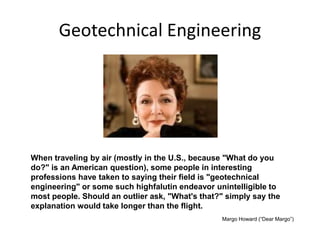Geotheta Can Be Fun For Everyone
Wiki Article
Things about Geotheta
Table of ContentsIndicators on Geotheta You Should KnowFascination About GeothetaTop Guidelines Of GeothetaThe Ultimate Guide To Geotheta
They team up with civil designers, structural engineers, architects, and other specialists to incorporate geotechnical factors to consider into the general project design and building procedure. This requires efficient synergy, coordination, and interaction to guarantee that the geotechnical elements straighten with the task objectives and meet governing requirements.Mining & Products Design: Principles of drilling, penetration rates, and factors impacting the choice of boring technique. Blowing up methods in surface and below ground workings. Mechanical and continual techniques to fragmentation, including longwall shearing and fullface boring.
Modelling of fragment and particle dimension distributions; comminution as a transfer function. Comminution innovation: squashing, grinding, dimension classification. Integrated analysis of fragmentation and comminution procedures. Supplied by: Mining & Products Engineering.
A Biased View of Geotheta
Bachelor's degree programs in civil, geotechnical, geological, and environmental engineering commonly last four years and consist of basic education training courses in English, social scientific research, and the humanities, along with training courses in advanced mathematics, structural geology, and fluid mineralogy. (https://medium.com/@ianhammond2191/about)Geotechnical engineering entails the evaluation of the dirt and rock conditions at a specific site, and their effects for the development of that site. As the majority of frameworks count on the ground for assistance, it lacks shock that a thorough understanding of the ground problems, and the viability of structure systems, are vital to the lasting stability and efficiency of the structure or framework.
Specialising in the investigation of geological formations and ground practices, geotechnical designers perform clinical examinations and testing to understand the effect these geological formations may carry the style and building and construction of building, civil and infrastructure tasks. This knowledge is critical for the design and building of structures, roads, passages, dams, bridges, and water system and sewer systems.
The geotechnical team at Douglas Allies consistently speak with engineers, design designers, programmers, and building contractors to make suggestions on layout and advancement propositions to make certain that the constructed frameworks are suitably created for the ground conditions. For instance, the design of footing systems requires to consider the weight of the structure, the ability of the ground to sustain that weight together with movement resistances and reliable building and construction.
Our Geotheta PDFs
This job is greatly simplified by the use of our Douglas Map geospatial platform that makes this details easily available in a very easy to use web internet browser interface. A geotechnical designer will guide the boring of boreholes and examination pits to gather soil and other samples, and likewise examine surface area attributes and ground exposures to develop a geotechnical design of the subsurface problems.Depending on the task type and ground conditions experienced, lab screening may among various other things analyze stamina, compressibility, reactivity and/or leaks in the structure of dirt and rock examples. After this data is gathered and collected, the results are used for a geotechnical model of the website, which is usually presented as sections across the website.

A geotechnical examination naturally can only examine the ground conditions at the places drilled or excavated. All-natural variations in dirt and rock conditions can take place throughout a site and in between test locations. It is therefore great practice that the geotechnical engineer be retained throughout building of the project to give on-site confirmation that the ground conditions come across follow the assumptions and recommendations given in the geotechnical investigation record.
Geotheta Things To Know Before You Get This
Geotechnical designers utilize their extensive understanding of soil and rock to assess threat and solve problems on diverse facilities projectsGeotechnical design is a specialist branch of civil engineering which considers the behaviour of earth materials and the application of dirt and rock technicians. Consulting Engineers. As a geotechnical designer, you will assess the physical, mechanical and chemical residential properties of dirt and rock in order to develop structures, retaining frameworks and earthworksGeotechnical engineering is very closely connected to and overlaps with, both engineering geology and ground design - https://www.intensedebate.com/people/geotheta. It's feasible to be experts in geotechnics or work for a geotechnical company yet be referred to as an engineering geologist or a ground designer. As a geotechnical designer, you'll need to: build and maintain partnerships with clients and various other professionals involved in the site, throughout each projectmaintain safety and security standards on site be mindful of price effects when you make recommendationsstudy geological maps and airborne photos from a series of sources and from various time periodsexamine building and construction prepares to see exactly how possible they are based upon your understanding of the siteinvestigate threats or geological risks for the sitesearch for eco sensitive features, such as garbage dump start to establish factual and interpretive ground modelsplan area investigationsdrill and evaluate examples of bedrock, dirt, groundwater and additional materials oversee other specialists on sitesolve technical problems as they occur, such as unanticipated structures at drill sitesmonitor problems throughout and after building and construction to make sure structures are stable in the brief and long termadding find this data gathered on website to your preliminary researchcreating geotechnical calculations, illustrations, and two or three-dimensional computer system designs translating the datamaking suggestions concerning the suggested use of the website

Report this wiki page